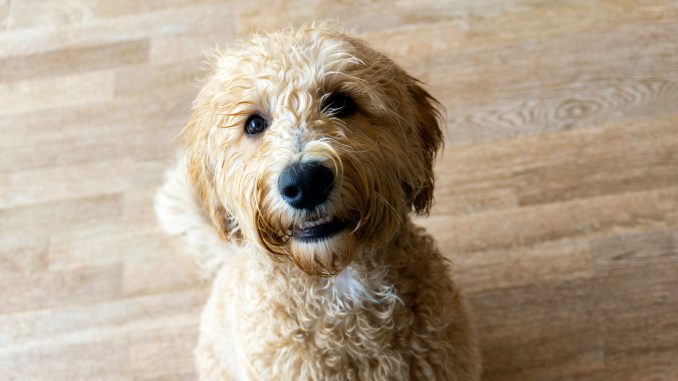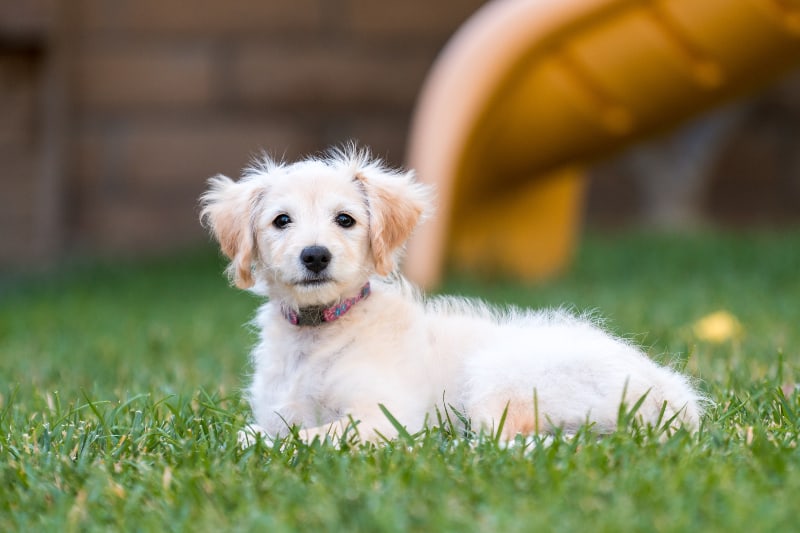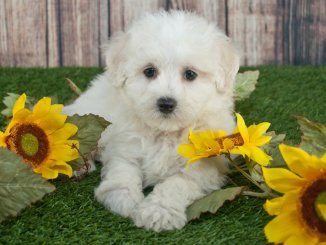If you’re considering adding a furry friend to your family, the Mini Labradoodle might just steal your heart. With their adorable appearance, friendly demeanor, and low-shedding coat, these pint-sized pooches have become increasingly popular among dog lovers.
A Mini Labradoodle is a cross between a Labrador Retriever and a Toy or Miniature Poodle. This mixed breed is also known as a Teacup Mini Labradoodle or Toy Labradoodle. The mix is much smaller than a standard labradoodle because the standard breed comes from a Labrador retriever and a standard poodle.
The mixed breed is a lovable and active pup that’s gentle with children of all ages. This dog is easy to train and friendly toward strangers and other pets. The Mini Labradoodle’s accepting nature makes it unsuitable to be a guard dog. However, this social dog can also be an excellent service dog because of its calm and intuitive nature.
Before you bring home your new four-legged friend, it’s essential to learn everything you need to know about caring for a Miniature Labradoodle. That’s where this complete guide comes in handy. From their origins and characteristics to training tips and common health concerns, I’ve got you covered every step of the way.
TABLE OF CONTENTS
- Mini Labradoodle Quick Summary
- Origins and History
- Breed Characteristics of A Mini Labradoodle
- Common Health Issues
- Care and Maintenance
- Training and Socialization
- The Cost of Living With A Mini Labradoodle
- So, Should You Get a Mini Labradoodle?
- FAQs on Minature Labradoodles
- Final Woof: Embracing the Mini Labradoodle Magic
Mini Labradoodle Quick Summary
Origins and History
Introduction to the Mini Labradoodle Breed
If you’re considering bringing home a Mini or Small Labradoodle, you might be curious about where these adorable hybrids came from. Well, let’s embark on a brief journey through their origins and history.
Brief History of the Labradoodle and Its Development
From Adobe Stock
Picture this: it’s the 1980s in Australia, and there’s a growing demand for hypoallergenic guide dogs. Enter the Labradoodle, a cross between a Labrador Retriever and a Poodle. This innovative blend combined the intelligence and trainability of the Labrador with the low-shedding, allergy-friendly coat of the Poodle. Fast forward a few decades, and breeders began experimenting with different sizes to accommodate various living situations and preferences, leading to the creation of the Mini Labradoodle.
Emergence of the Mini Labradoodle as a Smaller Variant
Now, you might wonder, what sets the Mini Labradoodle apart from its larger counterpart? Well, as the name suggests, Mini Labradoodles are bred to be smaller in size, making them a fantastic option for those who adore the Labradoodle’s traits but prefer a more compact canine companion. This downsizing process involved crossing miniature or toy Poodles with Labrador Retrievers, resulting in pups that retain the beloved characteristics of both parent breeds in a smaller package. So, if you’re looking for a pint-sized pooch with a big heart, the Mini Labradoodle might just steal yours.
Breed Characteristics of A Mini Labradoodle
From Adobe Stock
Physical Appearance and Coat Types
When it comes to Mini Labradoodles, their appearance can vary widely depending on factors such as genetics and breeding. Generally, you can expect these pups to exhibit a charming mix of features from their Labrador and Poodle parents. Their coats, in particular, can be curly, wavy, or straight, with colors ranging from cream and chocolate to black and apricot. One of the perks of Mini Labradoodles is their hypoallergenic coat, making them a great option for allergy sufferers.
Tempting Traits and Personality
Ah, the Mini Labradoodle’s personality—where do I begin? These pint-sized pooches are known for their friendly and affectionate nature, making them excellent companions for individuals and families alike. They thrive on human interaction and are often described as social butterflies, eagerly wagging their tails at the sight of a new friend. Mini Labradoodles are also highly intelligent and eager to please, which makes them a breeze to train. Whether you’re teaching them basic commands or advanced tricks, they’re sure to impress you with their quick learning abilities.
Exercise and Activity Needs
Despite their smaller size, Mini Labradoodles are no couch potatoes. These pups have the energy to spare and enjoy engaging in a variety of activities to keep both their bodies and minds stimulated. Daily walks, playtime in the yard, and interactive toys are all excellent ways to fulfill their exercise needs. Additionally, Mini Labradoodles thrive on mental challenges, so consider incorporating puzzle toys or training sessions into their routine to keep them entertained and satisfied.
The mini labradoodle was primarily bred using a miniature or toy poodle and a purebred Labrador Retriever as a family- and allergy-friendly breed. The mini dog is now created by breeding a mini labradoodle with a Labrador or miniature poodle. Sometimes, two minis are also bred together, resulting in a predictable temperament and appearance.
To understand the Mini Labradoodle, it’s helpful to know the parent breeds’ temperaments and appearances:
Labrador Retriever
The Labrador retriever was initially bred as a gun dog and became a popular family dog because of its friendly, energetic, and soft-hearted nature. The Labrador is a sensitive and loyal dog that loves to be around its family and shows protective qualities when needed.
These dogs love vigorous exercise alongside their owners, especially fetching games, water activities, and hiking. The breed is gentle and bred to work, making it well-suited as a service dog. The mini Labradoodle mix generally inherits the Labrador’s temperament, facial features, and body structure.
Toy or Miniature Poodle
The toy and miniature poodles were bred from the smallest standard poodles to create a miniature version of these low-shedding dogs in two sizes — miniature and toy. Mini Labradoodles share the qualities of standard poodles, including their intelligence, energy, and occasional stubbornness.
Miniature and toy poodles are elegant athletes with noble statures that are sure to draw attention at dog shows. These dogs are easy-going, friendly to children, love, companionship, and have thick, curly coats — all traits that are passed on to miniature Labradoodles.
Common Health Issues
Mini Labradoodles are generally healthy dogs, but like all breeds, they may be prone to certain health issues. Being aware of these potential concerns can help you provide the best care for your furry friend. Here are some common health issues to watch out for:
Hip Dysplasia
Hip dysplasia is a hereditary condition where the hip joint doesn’t develop properly, leading to instability and eventually arthritis. Symptoms may include limping, reluctance to move, and difficulty getting up or down stairs. While hip dysplasia cannot be cured, management options such as weight management, physical therapy, and joint supplements can help alleviate symptoms and improve your dog’s quality of life.
Progressive Retinal Atrophy (PRA)
Progressive retinal atrophy is a genetic eye disorder that causes gradual vision loss and can eventually lead to blindness. Symptoms may include night blindness, dilated pupils, and a reflective glow in the eyes. Unfortunately, there is no cure for PRA, but early detection through regular veterinary check-ups can help slow its progression and preserve your dog’s remaining vision.
Ear Infections
Due to their floppy ears and propensity for swimming, Mini Labradoodles may be prone to ear infections caused by bacteria, yeast, or parasites. Symptoms may include itching, redness, odor, and discharge from the ears. Regular ear cleaning and inspection can help prevent infections, while prompt veterinary treatment is essential if an infection does occur.
Allergies
Mini Labradoodles may suffer from allergies to environmental triggers such as pollen, dust mites, or certain foods. Symptoms can vary widely and may include itching, licking, chewing, sneezing, and skin rashes. Identifying and avoiding allergens, as well as working closely with your veterinarian to develop a management plan, can help keep your dog comfortable and reduce flare-ups.
Gastric Dilatation-Volvulus (GDV)
Also known as bloat, GDV is a life-threatening condition where the stomach fills with gas and twists on itself, cutting off blood flow. This emergency requires immediate veterinary attention. Symptoms may include a distended abdomen, unproductive retching, restlessness, and rapid breathing. While the exact cause of GDV is unknown, factors such as eating too quickly, exercising after meals, and stress may increase the risk.
By staying informed about these potential health issues and prioritizing preventive care, you can help ensure that your Mini Labradoodle enjoys a happy and healthy life by your side.
Obesity
Obesity is caused by overeating or thyroid problems and leads to other health issues. Prevent obesity by following the veterinarian’s guidance on how much to feed the dog. Be sure to limit treats to meet the dog’s required calorie intake.
Addison’s Disease
Also known as hypoadrenocorticism, is caused by a decreased production of hormones from the dog’s adrenal glands. This condition is life-threatening if left untreated, but the dog can live a full, healthy life with the proper treatment plan.
Exercise-induced Collapse
This health problem is common in mini Labradoodles because the dog tends to over-exert itself during exercise. Keep an eye on the dog during exercise and stop activities if the dog shows a lack of coordination or muscle weakness because these collapses are life-threatening in some cases
Centronuclear Myopathy
This is an inherited condition that causes a lack of muscle control in dogs. The illness is incurable, but treatment options are available to manage the disease.
From Adobe Stock
Care and Maintenance
Taking care of a Mini Labradoodle involves a combination of grooming, nutrition, exercise, and regular veterinary check-ups. Here’s how you can keep your furry friend looking and feeling their best:
Grooming
Mini Labradoodles have a coat that ranges from curly to wavy, which requires regular grooming to prevent mats and tangles. Brush your dog’s coat at least a few times a week, paying extra attention to areas prone to matting such as behind the ears and under the legs. Additionally, schedule professional grooming appointments every 6-8 weeks to keep their coat trimmed and tidy.
Nutrition
A balanced diet is essential for your Mini Labradoodle’s overall health and well-being. Choose a high-quality dog food that is appropriate for their age, size, and activity level. Monitor their food intake to prevent overeating and obesity, which can contribute to health problems such as joint issues and diabetes.
Generally, feed a miniature Labradoodle 1 to 2 ½ cups of high-quality dog kibble designed for small dogs. Split the food into at least two meals a day to avoid bloat and obesity. Always consult a veterinarian to determine the correct portion sizes for mixed-dog breeds.
Provide fresh water at all times and avoid feeding your dog table scraps or foods that may be toxic to dogs.
Exercise
Mini Labradoodles are active and energetic dogs that require daily exercise to stay happy and healthy. Aim for at least 30-60 minutes of physical activity each day, such as brisk walks, games of fetch, or interactive play sessions. Mental stimulation is just as important as physical exercise, so consider incorporating puzzle toys, training sessions, or scent games into your dog’s routine to keep their mind engaged.
Dental Care
Proper dental hygiene is crucial for preventing dental disease and maintaining your Mini Labradoodle’s oral health. Brush your dog’s teeth regularly with a dog-specific toothbrush and toothpaste, and provide dental chews or toys to help reduce plaque and tartar buildup. Schedule annual dental cleanings with your veterinarian to remove any stubborn plaque and ensure your dog’s teeth and gums are in tip-top shape.
Regular Veterinary Check-Ups
Routine veterinary check-ups are essential for monitoring your Mini Labradoodle’s overall health and catching any potential issues early on. Schedule annual wellness exams, vaccinations, and parasite prevention treatments to keep your dog healthy and protected against common diseases and pests. Additionally, be proactive about scheduling appointments if you notice any changes in your dog’s behavior, appetite, or appearance.
By following these care and maintenance tips, you can provide your Mini Labradoodle with the love and attention they deserve while helping them lead a long, happy, and healthy life by your side.
Training and Socialization
Training and socialization are crucial aspects of raising a well-behaved and well-adjusted Mini Labradoodle. With their intelligence and eager-to-please nature, these pups are typically quick learners, but consistent and positive reinforcement is key to success. Here’s how you can effectively train and socialize your Mini Labradoodle:
Basic Obedience Training
Start with basic obedience commands such as sit, stay, come, and down. Use positive reinforcement techniques like treats, praise, and affection to reward your dog for obeying commands. Keep training sessions short and fun, and be patient and consistent with your expectations. Practice these commands in different environments and gradually increase distractions to help your Mini Labradoodle generalize their training.
Leash Training
Teach your Mini Labradoodle to walk politely on a leash without pulling or lunging. Begin by introducing them to the leash and collar or harness positively and gradually. Use treats and verbal praise to encourage them to walk by your side, and stop and wait for them to calm down if they start pulling. Consistency is key, so be sure to reinforce good leash manners during every walk.
Socialization
Expose your Mini Labradoodle to a variety of people, animals, sounds, and environments from a young age to help them become confident and well-adjusted adults. Arrange playdates with other dogs, take them to dog-friendly parks and events, and invite friends and family members over to meet your puppy. Encourage positive interactions and monitor their body language to ensure they feel comfortable and safe in new situations.
Behavioral Training
Address any behavioral issues such as jumping, barking, or chewing early on to prevent them from becoming ingrained habits. Redirect undesirable behaviors with alternative activities or commands, and avoid punishment-based methods that can damage your bond with your dog. Consider enrolling in a puppy kindergarten class or working with a professional trainer if you need extra help tackling specific behavior challenges.
By investing time and effort into training and socialization, you can help your Mini Labradoodle become a well-mannered and confident companion that you’ll be proud to take anywhere.
The Cost of Living With A Mini Labradoodle
From Adobe Stock
Ah, the million-dollar question—well, maybe not quite that much, but it’s certainly an important consideration when thinking about bringing a Mini Labradoodle into your life. The cost of a Mini Labradoodle can vary depending on factors such as breeder reputation, pedigree, coat color, and geographical location.
A Mini Labradoodle costs $500 to $2,500. Buying this breed from a reputable breeder costs more than $1,500, increasing when fewer breeders are in the area. This designer dog breed often ends up at rescue centers, and adopting a rescue Mini Lab costs about $500. Adopting older dogs is the cheapest option, but remember that the temperament and behavior of the dog are already fixed.
Keep in mind that this initial purchase price is just the beginning of your financial commitment. You’ll also need to budget for ongoing expenses such as food, grooming, veterinary care, training, and supplies.
On average, raising a Mini Labradoodle costs between $1,000 to $3,000 for the first year of care. The cost decreases slightly after the initial fees, but the grooming, healthcare, and food costs vary greatly based on the dog’s size.
While the upfront cost may seem steep, the joy and companionship that a Mini Labradoodle can bring to your life are truly priceless.
So, Should You Get a Mini Labradoodle?
From Adobe Stock
As much as I’d love to give a definitive answer, the decision to bring a Mini Labradoodle into your life ultimately depends on your lifestyle, preferences, and commitment to responsible pet ownership. Before making this important decision, ask yourself the following questions:
- Do I have the time and energy to devote to caring for a Mini Labradoodle?
- Am I prepared for the financial responsibility of owning a dog?
- Is my living situation suitable for a Mini Labradoodle?
- Am I willing to invest in training and socialization to ensure my dog’s well-being?
- Can I provide a loving and stable home for a Mini Labradoodle for their entire life?
Here are other things to remember:
The Mini Lab is an excellent dog for families and elderly owners because of its gentle and playful nature. However, consider a few things before choosing this mixed breed because the dog is unsuitable for some lifestyles.
Mini Labradoodles are Suitable for:
Mini Labs are suitable for new and experienced owners, including families with young children and older owners. These designer dogs are gentle and easy to care for apart from their demanding exercise and grooming requirements. Because of its energetic nature, this dog is well suited for active owners who want to take the dog along during vigorous adventure exercise.
These designer dogs are suitable for owners who stay home often, but the dogs are also small enough to go on errands with the owner. Mini Labradoodles are an excellent choice as a small companion dog or lapdog for single owners because of the dog’s lovable and caring attitude.
This mixed breed is suitable for most allergy sufferers because of the dog’s low-shedding tendency. However, to ensure the dog’s fur doesn’t trigger allergies, potential owners should spend some time with the dog first.
Mini Labradoodles are suitable for smaller homes and apartments as long as the dog has spaces to run around, whether it’s a small yard or an open space in the home. This miniature dog adapts to smaller spaces but still needs daily vigorous exercise.
Mini Labradoodles are NOT Suitable for:
Mini Labs are prone to separation anxiety, making these dogs unsuitable for owners who are out of the house for eight or more hours a day. The small dogs can only handle being left alone for short periods.
The mixed breed is unsuitable for owners who can’t afford professional grooming because, despite being low-shedders, the dogs have thick curls that need regular grooming.
These dogs are unsuitable for inactive families because of their exercise and mental stimulation needs. This mixed breed becomes destructive and disobedient when the care requirements aren’t met.
The Mini Labradoodle is unsuitable for owners who want a predictable dog because of the mixed breed’s variations in size and temperament. Second-generation Mini Labradoodles — bred from two labradoodle parents — have more predictable appearances and personalities.
FAQs on Minature Labradoodles
Are Mini Labradoodles Hypoallergenic?
While no dog is completely hypoallergenic, Mini Labradoodles are often considered more allergy-friendly than other breeds due to their low-shedding coats. However, individual reactions can vary, so it’s essential to spend time with a Mini Labradoodle before bringing one home if you have allergies.
How Big Do Mini Labradoodles Get?
Mini Labradoodles typically weigh between 15 to 30 pounds and stand 14 to 16 inches tall at the shoulder, although size can vary depending on genetics and breeding.
Do Mini Labradoodles Require A Lot of Exercise?
Mini Labradoodles are moderately active dogs that benefit from daily exercise to keep them mentally and physically stimulated. Aim for at least 30 to 60 minutes of exercise each day, such as walks, playtime, or training sessions.
Are Mini Labs Good With Children and Other Pets?
Mini Labradoodles are known for their friendly and sociable nature, making them excellent companions for children and other pets when properly socialized and trained from a young age.
Do Mini Labradoodles Shed?
Mini Labradoodles typically have a low-shedding coat, thanks to their Poodle ancestry. However, it’s essential to note that no dog is completely non-shedding, and individual Mini Labradoodles may still shed minimally. Regular grooming and brushing can help minimize shedding and keep your dog’s coat healthy and tidy.
How Long Do Mini Labradoodles Live?
On average, Mini Labradoodles have a lifespan of 10 to 18 years, although individual longevity can vary depending on factors such as genetics, diet, exercise, and overall health care. Providing your Mini Labradoodle with proper nutrition, regular veterinary check-ups, exercise, and love and attention can help maximize their lifespan and quality of life.
Final Woof: Embracing the Mini Labradoodle Magic
Well, there you have it—the ins and outs of living with a Mini Labradoodle! Whether you’re drawn to their adorable appearance, friendly disposition, or low-shedding coat, Mini Labradoodles have a lot to offer as beloved family pets. From their puppy antics to their unwavering loyalty, these pint-sized pooches are sure to steal your heart and bring endless joy to your life.
But remember, owning a Mini Labradoodle is a commitment that requires time, patience, and dedication. By providing them with love, care, and proper training, you’ll be rewarded with a faithful companion who will stand by your side through thick and thin.
So, if you’re ready to embark on this adventure of a lifetime, why wait? Your Mini Labradoodle is out there waiting for you to bring them home and start making memories together. Here’s to many years of wagging tails, wet noses, and unconditional love—cheers to the wonderful world of Mini Labradoodles!










How long does it take to crate train a miniature Labradoodle puppy please
Not long for my mini. Fully house broken one week after we took him
Home.